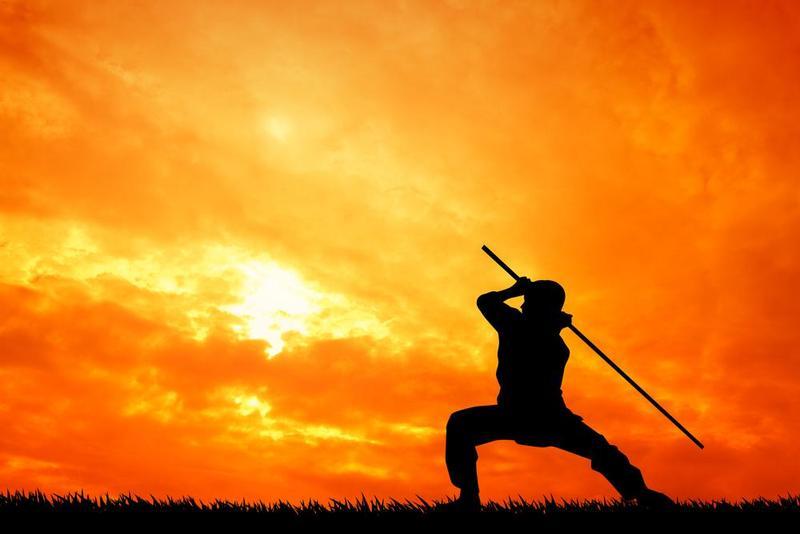Many of us hold a perception of T’ Chi Ch’uan as a slow and gentle series of movements done by old folks in the park. Nothing could be further from the truth. The practice of T’ai Chi requires tremendous strength, endurance and flexibility, as well as demanding enormous and focus. In addition, properly applied, it is one of the deadliest and most devastating of the martial arts. A kind of moving meditation, it is a marvelous vehicle for cultivating the harmonization of body, mind and spirit, while promoting health and longevity.
T’ai Chi Ch’uan, or the Supreme Ultimate Fist, derives its name from the great T’ai Chi. In the West, this is familiar to us as Yin and Yang, and, like Yin and Yang, the practice of T’ai Chi establishes a balance and flow of opposites.
Systems of T’ai Chi come in a few different flavors, the most familiar being the 64 movement Yang Short Form, which was introduced to this country by Chen Man Ching, and is derived from a longer 128 movement form. The numbers 64 and 128 are not exact, but are symbolically important in the Taoist lexicon; the actual numbers you get depend upon how you count the movements.
T’ai Chi is typically included in the Wu D’an Mountain martial styles. A marvelous and fairly accurate compendium of these styles can be found in the film “Crouching Tiger, Hidden Dragon” (hold a little space for the wire work; it’s an exaggeration of an actual technique known as “Cloud Walking”). The four major T’ai Chi systems - Yang, Chen, Wu and Sun - are known as “family styles”, each having a lineage that can be traced back to a specific village or clan, then later co-opted by the practitioners at Wu D’an to be included in their repertoire.
Yang is the most commonly taught style. Chen, the most explosive and combat oriented style, has become more popular in recent years, with Master Ren Guang Yi, one of only six living Chen Masters, now teaching publically on the East Coast. Wu and Sun are both a bit harder to find, but still available to the general public. There are also other, more esoteric styles, like “Needle in the Pillow”, although these are typically reserved for what are known as Inner Chamber disciples; practitioners who are themselves Masters or pretty close.
From a physiological standpoint, T’ai Chi, much like Yoga, cleanses and invigorates by increasing the flow of fluids through the body, as well as flushing the lymph nodes and lymphatic system. Its practice increases heart rate and blood flow, and also prompts the movement of joints through their full range of motion.
Energetically, T’ai Chi encourages drawing power “up from the mountain”, promoting balance and physical strength, and movement “down from the heavens”, increasing flexibility and range of motion. These two opposing elements come together in the 2nd chakra or t’an t’ien (pr., DON dee-EN), increasing the flow of “chi”, or vital force.
Although we tend to think of martial arts as all about punching, kicking and jumping around, it’s really all about the hips and the waist. Again, like Yoga, which encourages the blending of prana (chi) and apana in the 3rd chakra, with T’ai Chi the balance of movement and stillness that coalesces in the 2nd chakra creates a very specific sort of flow that promotes overall health and wellness. This is due, in part, to the circular movement of the core, which massages the major organs and increases flexion in the connective tissue of the torso.
Metaphysically, T’ai Chi promotes . The mind is emptied, as with sitting or standing meditation, and the focus becomes fixed on matching the flow of the breath with the flow of the body. This emptying of the mind is akin to the dropping of the ego in Zen and brings us into the larger “flow” of the universe, or Tao. This of movement and mindfulness is the epitome of moving meditation.
The metaphysical aspects of T’ai Chi find their practical application in the psychological benefits enjoyed by practitioners. Like sitting meditation, T’ai Chi promotes psychic balance, diminishes , increases focus and concentration, and generally supports an overall sense of psychological wellness.
One word of caution - a little knowledge is dangerous. Although T’ai Chi is a martial art, unless one is taught the proper martial application of its techniques the results of the roundly unfortunate I-take-a-kickboxing-class-at-the-gym-so-I-know-Karate mistake can be disastrous.
Personally, I have taught, studied and practiced martial arts for almost 35 years, and I’ve met more than my share of black belts who can’t fight their way out of a paper bag. Quite frankly, early on I was one of them. Knowing and applying are two very different things, and without proper instruction in application, odds are you’ll get hurt, or even hurt yourself.
That said, and as with all things, if the practice of T’ai Chi Ch’uan is undertaken with sincerity, humility and good intention, it can only bring joy, contentment and peace.
Be the first to post a message!
